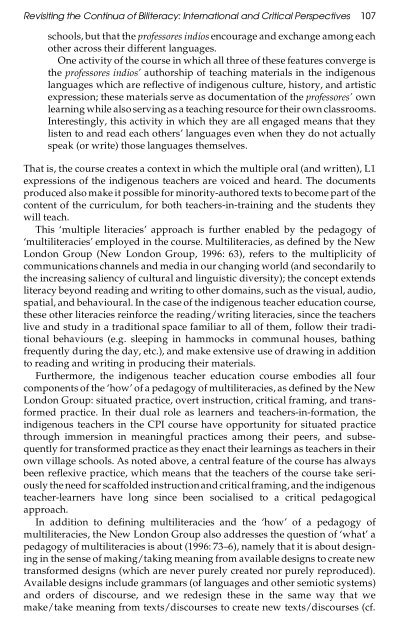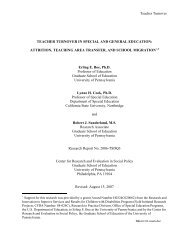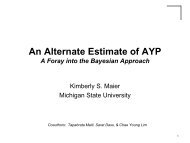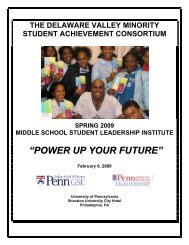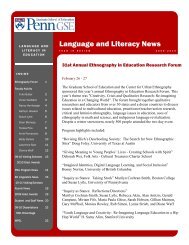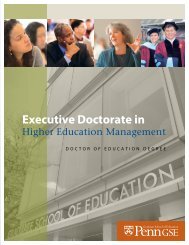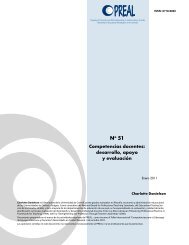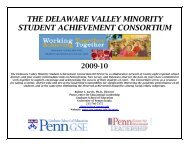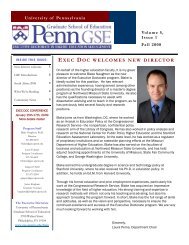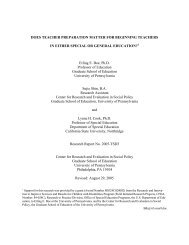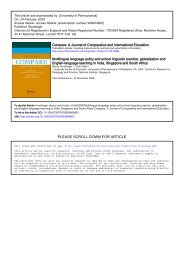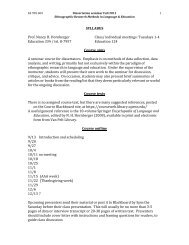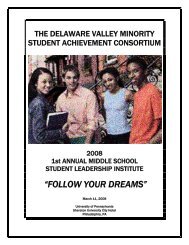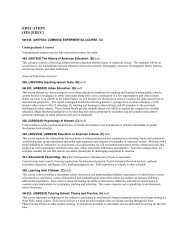Revisiting the Continua of Biliteracy - Penn GSE - University of ...
Revisiting the Continua of Biliteracy - Penn GSE - University of ...
Revisiting the Continua of Biliteracy - Penn GSE - University of ...
Create successful ePaper yourself
Turn your PDF publications into a flip-book with our unique Google optimized e-Paper software.
<strong>Revisiting</strong> <strong>the</strong> <strong>Continua</strong> <strong>of</strong> <strong>Biliteracy</strong>: International and Critical Perspectives 107<br />
schools, but that <strong>the</strong> pr<strong>of</strong>essores indios encourage and exchange among each<br />
o<strong>the</strong>r across <strong>the</strong>ir different languages.<br />
One activity <strong>of</strong> <strong>the</strong> course in which all three <strong>of</strong> <strong>the</strong>se features converge is<br />
<strong>the</strong> pr<strong>of</strong>essores indios’ authorship <strong>of</strong> teaching materials in <strong>the</strong> indigenous<br />
languages which are reflective <strong>of</strong> indigenous culture, history, and artistic<br />
expression; <strong>the</strong>se materials serve as documentation <strong>of</strong> <strong>the</strong> pr<strong>of</strong>essores’ own<br />
learning while also serving as a teaching resource for <strong>the</strong>ir own classrooms.<br />
Interestingly, this activity in which <strong>the</strong>y are all engaged means that <strong>the</strong>y<br />
listen to and read each o<strong>the</strong>rs’ languages even when <strong>the</strong>y do not actually<br />
speak (or write) those languages <strong>the</strong>mselves.<br />
That is, <strong>the</strong> course creates a context in which <strong>the</strong> multiple oral (and written), L1<br />
expressions <strong>of</strong> <strong>the</strong> indigenous teachers are voiced and heard. The documents<br />
produced also make it possible for minority-authored texts to become part <strong>of</strong> <strong>the</strong><br />
content <strong>of</strong> <strong>the</strong> curriculum, for both teachers-in-training and <strong>the</strong> students <strong>the</strong>y<br />
will teach.<br />
This ‘multiple literacies’ approach is fur<strong>the</strong>r enabled by <strong>the</strong> pedagogy <strong>of</strong><br />
‘multiliteracies’ employed in <strong>the</strong> course. Multiliteracies, as defined by <strong>the</strong> New<br />
London Group (New London Group, 1996: 63), refers to <strong>the</strong> multiplicity <strong>of</strong><br />
communications channels and media in our changing world (and secondarily to<br />
<strong>the</strong> increasing saliency <strong>of</strong> cultural and linguistic diversity); <strong>the</strong> concept extends<br />
literacy beyond reading and writing to o<strong>the</strong>r domains, such as <strong>the</strong> visual, audio,<br />
spatial, and behavioural. In <strong>the</strong> case <strong>of</strong> <strong>the</strong> indigenous teacher education course,<br />
<strong>the</strong>se o<strong>the</strong>r literacies reinforce <strong>the</strong> reading/writing literacies, since <strong>the</strong> teachers<br />
live and study in a traditional space familiar to all <strong>of</strong> <strong>the</strong>m, follow <strong>the</strong>ir traditional<br />
behaviours (e.g. sleeping in hammocks in communal houses, bathing<br />
frequently during <strong>the</strong> day, etc.), and make extensive use <strong>of</strong> drawing in addition<br />
to reading and writing in producing <strong>the</strong>ir materials.<br />
Fur<strong>the</strong>rmore, <strong>the</strong> indigenous teacher education course embodies all four<br />
components <strong>of</strong> <strong>the</strong> ‘how’ <strong>of</strong> a pedagogy <strong>of</strong> multiliteracies, as defined by <strong>the</strong> New<br />
London Group: situated practice, overt instruction, critical framing, and transformed<br />
practice. In <strong>the</strong>ir dual role as learners and teachers-in-formation, <strong>the</strong><br />
indigenous teachers in <strong>the</strong> CPI course have opportunity for situated practice<br />
through immersion in meaningful practices among <strong>the</strong>ir peers, and subsequently<br />
for transformed practice as <strong>the</strong>y enact <strong>the</strong>ir learnings as teachers in <strong>the</strong>ir<br />
own village schools. As noted above, a central feature <strong>of</strong> <strong>the</strong> course has always<br />
been reflexive practice, which means that <strong>the</strong> teachers <strong>of</strong> <strong>the</strong> course take seriously<br />
<strong>the</strong> need for scaffolded instructionand criticalframing, and <strong>the</strong> indigenous<br />
teacher-learners have long since been socialised to a critical pedagogical<br />
approach.<br />
In addition to defining multiliteracies and <strong>the</strong> ‘how’ <strong>of</strong> a pedagogy <strong>of</strong><br />
multiliteracies, <strong>the</strong> New London Group also addresses <strong>the</strong> question <strong>of</strong> ‘what’ a<br />
pedagogy <strong>of</strong> multiliteracies is about (1996: 73–6), namely that it is about designing<br />
in <strong>the</strong> sense <strong>of</strong> making/taking meaning from available designs to create new<br />
transformed designs (which are never purely created nor purely reproduced).<br />
Available designs include grammars (<strong>of</strong> languages and o<strong>the</strong>r semiotic systems)<br />
and orders <strong>of</strong> discourse, and we redesign <strong>the</strong>se in <strong>the</strong> same way that we<br />
make/take meaning from texts/discourses to create new texts/discourses (cf.


